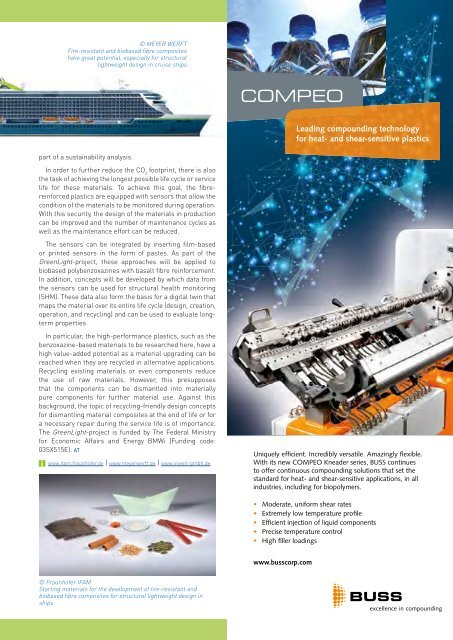issue 05/2021
Highlights: Fibres, Textiles, Nonwovens Biocomposites Basics: CO2-based plastics
Highlights:
Fibres, Textiles, Nonwovens
Biocomposites
Basics: CO2-based plastics
Create successful ePaper yourself
Turn your PDF publications into a flip-book with our unique Google optimized e-Paper software.
© MEYER WERFT<br />
Fire-resistant and biobased fibre composites<br />
have great potential, especially for structural<br />
lightweight design in cruise ships<br />
COMPEO<br />
Leading compounding technology<br />
for heat- and shear-sensitive plastics<br />
Biocomposites<br />
part of a sustainability analysis.<br />
In order to further reduce the CO 2<br />
footprint, there is also<br />
the task of achieving the longest possible life cycle or service<br />
life for these materials. To achieve this goal, the fibrereinforced<br />
plastics are equipped with sensors that allow the<br />
condition of the materials to be monitored during operation.<br />
With this security, the design of the materials in production<br />
can be improved and the number of maintenance cycles as<br />
well as the maintenance effort can be reduced.<br />
The sensors can be integrated by inserting film-based<br />
or printed sensors in the form of pastes. As part of the<br />
GreenLight-project, these approaches will be applied to<br />
biobased polybenzoxazines with basalt fibre reinforcement.<br />
In addition, concepts will be developed by which data from<br />
the sensors can be used for structural health monitoring<br />
(SHM). These data also form the basis for a digital twin that<br />
maps the material over its entire life cycle (design, creation,<br />
operation, and recycling) and can be used to evaluate longterm<br />
properties.<br />
In particular, the high-performance plastics, such as the<br />
benzoxazine-based materials to be researched here, have a<br />
high value-added potential as a material upgrading can be<br />
reached when they are recycled in alternative applications.<br />
Recycling existing materials or even components reduce<br />
the use of raw materials. However, this presupposes<br />
that the components can be dismantled into materially<br />
pure components for further material use. Against this<br />
background, the topic of recycling-friendly design concepts<br />
for dismantling material composites at the end of life or for<br />
a necessary repair during the service life is of importance.<br />
The GreenLight-project is funded by The Federal Ministry<br />
for Economic Affairs and Energy BMWi (Funding code:<br />
03SX515E). AT<br />
www.ifam.fraunhofer.de | www.meyerwerft.de | www.invent-gmbh.de<br />
Uniquely efficient. Incredibly versatile. Amazingly flexible.<br />
With its new COMPEO Kneader series, BUSS continues<br />
to offer continuous compounding solutions that set the<br />
standard for heat- and shear-sensitive applications, in all<br />
industries, including for biopolymers.<br />
• Moderate, uniform shear rates<br />
• Extremely low temperature profile<br />
• Efficient injection of liquid components<br />
• Precise temperature control<br />
• High filler loadings<br />
www.busscorp.com<br />
© Fraunhofer IFAM<br />
Starting materials for the development of fire-resistant and<br />
biobased fibre composites for structural lightweight design in<br />
ships<br />
bioplastics MAGAZINE [<strong>05</strong>/21] Vol. 16 39

















